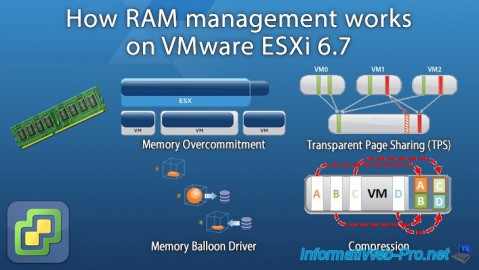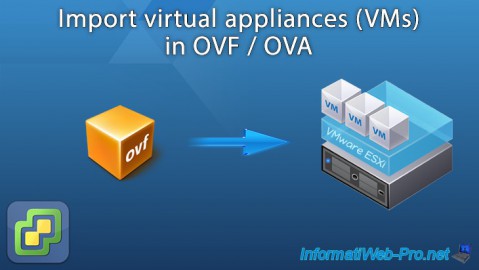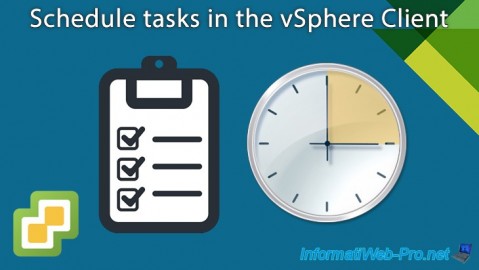Create a Virtual Distributed Switch (vDS) on VMware vSphere 6.7 and migrate hosts and VCSAs to it
- VMware
- VMware vCenter Server (VCSA), VMware vSphere
- 27 December 2024 at 08:55 UTC
-

- 3/7
If you go to the "Ports" tab of your distributed virtual switch (MyDSwitch), you will see that the virtual machine of your VMware ESXi host is connected to one of the ports of your distributed port group "DPortGroup_VMs".

Further down, you will see that the VMkernel network adapter "vmk0" from your VMware ESXi host is connected to a port in your distributed port group "DPortGroup_Mgmt".

Further down, you will see that the VMkernel network adapter "vmk1" from your VMware ESXi host is connected to a port in your distributed port group "DPortGroup_vMotion".

At the very bottom, you will see that the physical adapters (vmnic0, vmnic1, ...) of your VMware ESXi host are connected to ports in your "MyDSwitch-DVUplinks-xx" uplink port group.

In the "Hosts" tab of your "MyDSwitch" distributed virtual switch, you will see the VMware ESXi host that you have just added to it.

In the "VM" tab of this distributed virtual switch, you will see the virtual machine(s) of the host that you have just added on it (if you have migrated your virtual machines to a distributed port group of this distributed virtual switch).

In the "Networks" tab of this distributed virtual switch, you will see the list of distributed port groups present on it, as well as the uplink port group by clicking on the "Uplink Port Groups" subtab rising.

You can also filter the display of connected ports, hosts and virtual machines (VMs) by selecting the desired port group.
So, if you select the "DPortGroup_Mgmt" distributed port group and go to the "Ports" tab, you will only see the ports available on that distributed port group.
In this case, you will only see the VMkernel network adapter "vmk0" of your VMware ESXi host since this is the one we used to manage our VMware ESXi host.

If you select the distributed port group "DPortGroup_vMotion" and go to the "Ports" tab, you will see that the VMkernel network adapter "vmk1" (used for vMotion in our case) is connected.

For the distributed port group "DPortGroup_VMs", you will see that your virtual machines are connected to the ports there.

If you select the "MyDSwitch-DVUplinks-xx" uplink port group and go to the "Ports" tab, you will see that several uplinks are mapped to the physical adapters (physical network cards) of your VMware host ESXi.

If you go to the "Summary" tab of this uplink group, you will see that the ports are in use (since the uplinks are already mapped to at least one VMware ESXi host).

If you select one of the virtual machines on your VMware ESXi host connected to your virtual distributed switch (vDS), you will see that it is connected to a distributed port group (in our case: DPortGroup_VMs) instead of the old group ports (e.g. VM Network).

Select your VMware ESXi host (connected to your virtual distributed switch (vDS)) and go to "Configure -> Networking -> VMkernel adapters".
As you can see, the VMkernel network adapters of this VMware ESXi host are connected to distributed port groups (in our case: DPortGroup_Mgmt and DPortGroup_vMotion) of your distributed virtual switch (in our case: MyDSwitch).

6. Lost physical adapter (physical network adapter) associations
If you go back to step 2 of this tutorial, you will see that the host management (via the "vmk0" interface) and the VM migration (via the "vmk1" interface) used physical adapters (vmnicX) different.
Which is no longer the case since you use the Virtual Distributed Switch (vDS).
Indeed, if you select your VMware ESXi host and go to "Configure -> Networking -> Virtual switches", you will see that all physical adapters can be used, regardless of the VMkernel interface or group of ports you select.



If necessary, note that you can see which physical adapter (physical network card) is mapped to an uplink of this distributed virtual switch by clicking on the name of the uplink (Uplink X) you want.

7. Manage association and failover of physical adapters across distributed port groups
To manage the association of physical adapters on your distributed port groups, go to the "Networking" section of your inventory and select the desired distributed port group.
Then go to "Configure -> Settings -> Properties" and click: Edit.

In the "[distributed port group name] - Edit Settings" window that appears, go to the "Teaming and failover" section.
As you can see, by default all uplinks (Uplink X) are set as active uplinks.
Which means they will always be in use (using the load balancing technique defined above).
To make a port group use only certain uplinks, simply move the other uplinks to the "Unused uplinks" section of the failover order.

In our case, we assign the uplinks "Uplink 1" and "Uplink 2" to our port group "DPortGroup_Mgmt".

In our case, we assign the uplinks "Uplink 3" and "Uplink 4" to our port group "DPortGroup_vMotion".
Indeed, the network traffic due to the migration of virtual machines passes, in our case, via a separate network (to which these 2 uplinks are connected via the physical adapters "vmnic2" and "vmnic3" of our hosts).

For our virtual machines' network traffic, we chose to use the "Uplink 1" and "Uplink 2" uplinks.

Once you have configured the uplink associations on your port groups, select your VMware ESXi host and go to: Configure -> Networking -> Virtual switches.

Click on the name of a distributed port group of your distributed virtual switch and you will see which physical adapters will be used for it.
In our case, we can see that the port group "DPortGroup_Mgmt" will only use the physical adapters "vmnic0" and "vmnic1" from our hosts.

In our case, the "DPortGroup_vMotion" port group will only use the physical adapters "vmnic2" and "vmnic3" from our hosts.

In our case, the port group "DPortGroup_Mgmt" will only use the physical adapters "vmnic0" and "vmnic1" from our hosts.

Share this tutorial
To see also
-

VMware 4/7/2023
VMware ESXi 6.7 - How memory (RAM) management works
-

VMware 8/26/2022
VMware ESXi 7.0 / 6.7 - Import VMs from OVF / OVA format
-

VMware 7/3/2024
VMware vSphere 6.7 - Scheduled tasks
-

VMware 6/28/2024
VMware vSphere 6.7 - Tasks and events

No comment